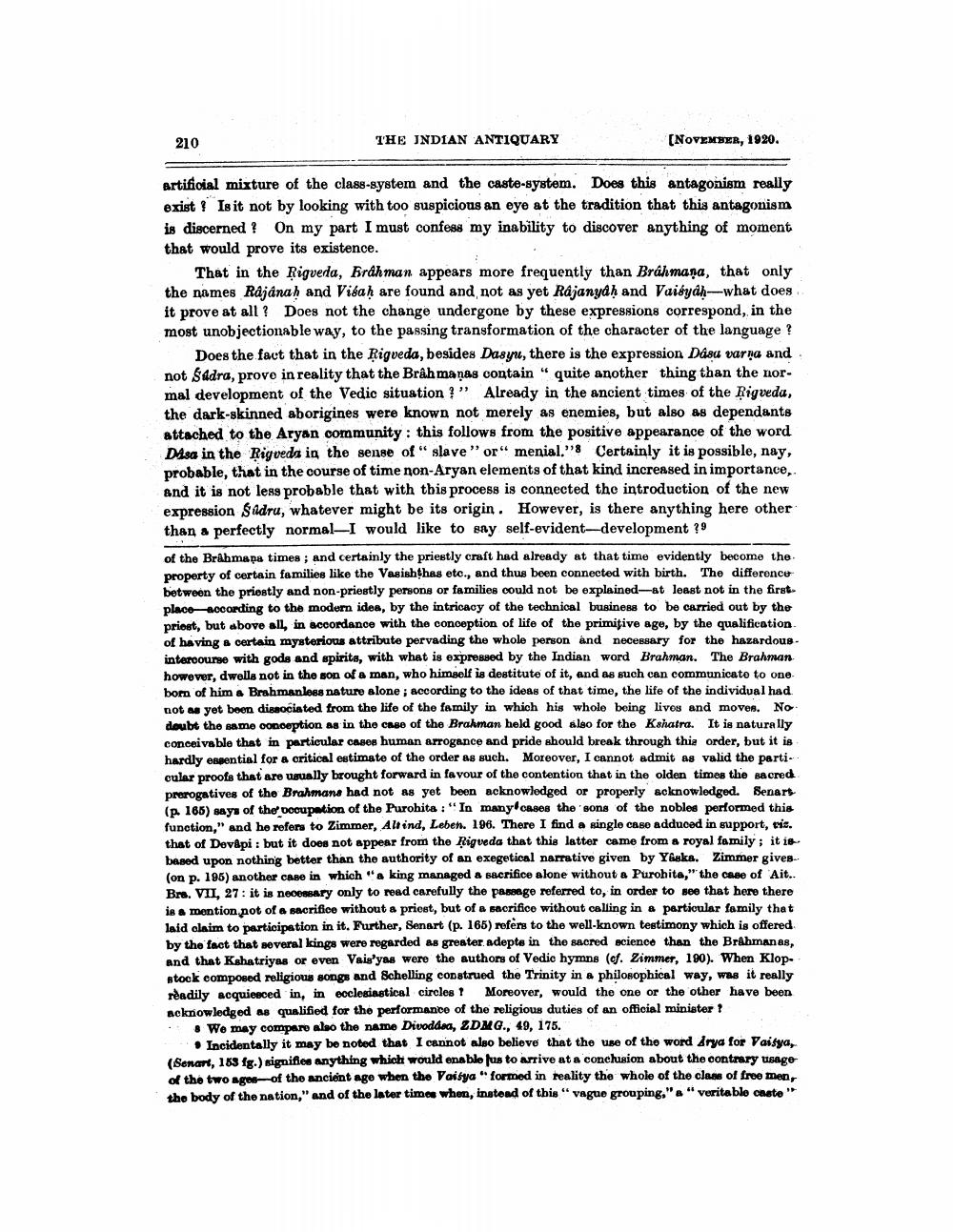________________
210
THE INDIAN ANTIQUARY
(NOVEMBER, 1920.
artificial mixture of the class-system and the caste-system. Does this antagonism really exist Is it not by looking with too suspicious an eye at the tradition that this antagonism is discerned ? On my part I must confess my inability to discover anything of moment that would prove its existence.
That in the Rigveda, Brdh man appears more frequently than Brahmaņa, that only the names Rájánah and Vitaḥ are found and not as yet Rajanyaḥ and Vaibyah-what does it prove at all? Does not the change undergone by these expressions correspond, in the most unobjectionable way, to the passing transformation of the character of the language ?
Does the fact that in the Rigveda, besides Dasyu, there is the expression Dásu varna and not Sedra, prove in reality that the Brâh maņas contain " quite another thing than the normal development of the Vedic situation !” Already in the ancient times of the Rigveda, the dark-skinned aborigines were known not merely as enemies, but also as dependants attached to the Aryan community: this follows from the positive appearance of the word Dasa in the Rigveda in the sense of "slave" or“ menial.” Certainly it is possible, nay, probable, that in the course of time non-Aryan elements of that kind increased in importance, and it is not less probable that with this process is connected the introduction of the new expression Sadru, whatever might be its origin. However, is there anything here other than a perfectly normal—I would like to say self-evident-development ?9 of the Brahmapa times; and certainly the priestly craft had already at that time evidently become the property of certain families like the Vasishthas etc., and thus been connected with birth. The difference between the priestly and non-priestly persons or families could not be explained-at least not in the first place according to the modern idea, by the intricacy of the technical business to be carried out by the priost, but above all, in accordance with the conception of life of the primitive age, by the qualification of having a certain mysterious attribute pervading the whole person and necessary for the hazardous. intercourse with gods and spirits, with what is expressed by the Indian word Brahman. The Brahman however, dwells not in the son of a man, who himself is destitute of it, and as such can communicate to oneborn of him a Brahmanlons nature alone; according to the ideas of that time, the life of the individual had not as yet been dissociated from the life of the family in which his whole being lives and moves. No doubt the same conception as in the case of the Brakman held good also for the Kshatra. It is naturally conceivable that in particular casos human arrogance and pride should break through this order, but it is hardly expential for a critical estimate of the order as such. Moreover, I cannot admit as valid the parti. cular proofs that are usually brought forward in favour of the contention that in the olden times the sacred prerogatives of the Brahmans had not as yet been acknowledged or properly acknowledged. Benars (p. 166) says of the pooupation of the Purohita : "In many cases the sons of the nobles performed this function," and he refer to Zimmer, Alt ind, Leben. 196. There I find a single caso adduced in support, tis. that of Devapi: but it does not appear from the Rigveda that this latter came from a royal family; it is based upon nothing better than the authority of an exegetical narrative given by Yaka. Zimmer gives (on p. 195) another case in which "a king managed a sacrifice alone without a Purohita," the code of Ait.. Brs. VII, 27: it is necessary only to read carefully the passage referred to, in order to see that here there is a mention pot of a sacrifice without a priest, but of a sacrifice without calling in a partioular family that laid claim to participation in it. Further, Senart (p. 165) refers to the well-known testimony which is offered by the fact that several kings were regarded as greater adepte in the sacred science than the Brahmanas, and that Kshatriyas or even Vais'yas were the authors of Vedic hymns (cf. Zimmer, 100). When KlopAtock composed religious songs and Schelling construed the Trinity in a philosophical way, was it really readily acquienced in, in coclesiastical circles! Moreover, would the one or the other have been acknowledged a qualified for the performance of the religious duties of an official minister ! - We may compare also the name Divoddea, ZDMG., 49, 175. - Incidentally it may be noted that I cannot also believe that the use of the word arya for Vaisya (Senant, 183 .) Rignifiee anything which would enable us to arrive at a conclusion about the oontrary usage of the two of the ancient ago when the Varsya " formed in reality the whole of the class of free men, the body of the nation," and of the later times when, instead of this "vague grouping." "veritable caste"




